MERCEDES-BENZ SL ROADSTER 2016 Owners Manual
Manufacturer: MERCEDES-BENZ, Model Year: 2016, Model line: SL ROADSTER, Model: MERCEDES-BENZ SL ROADSTER 2016Pages: 333, PDF Size: 11.85 MB
Page 141 of 333
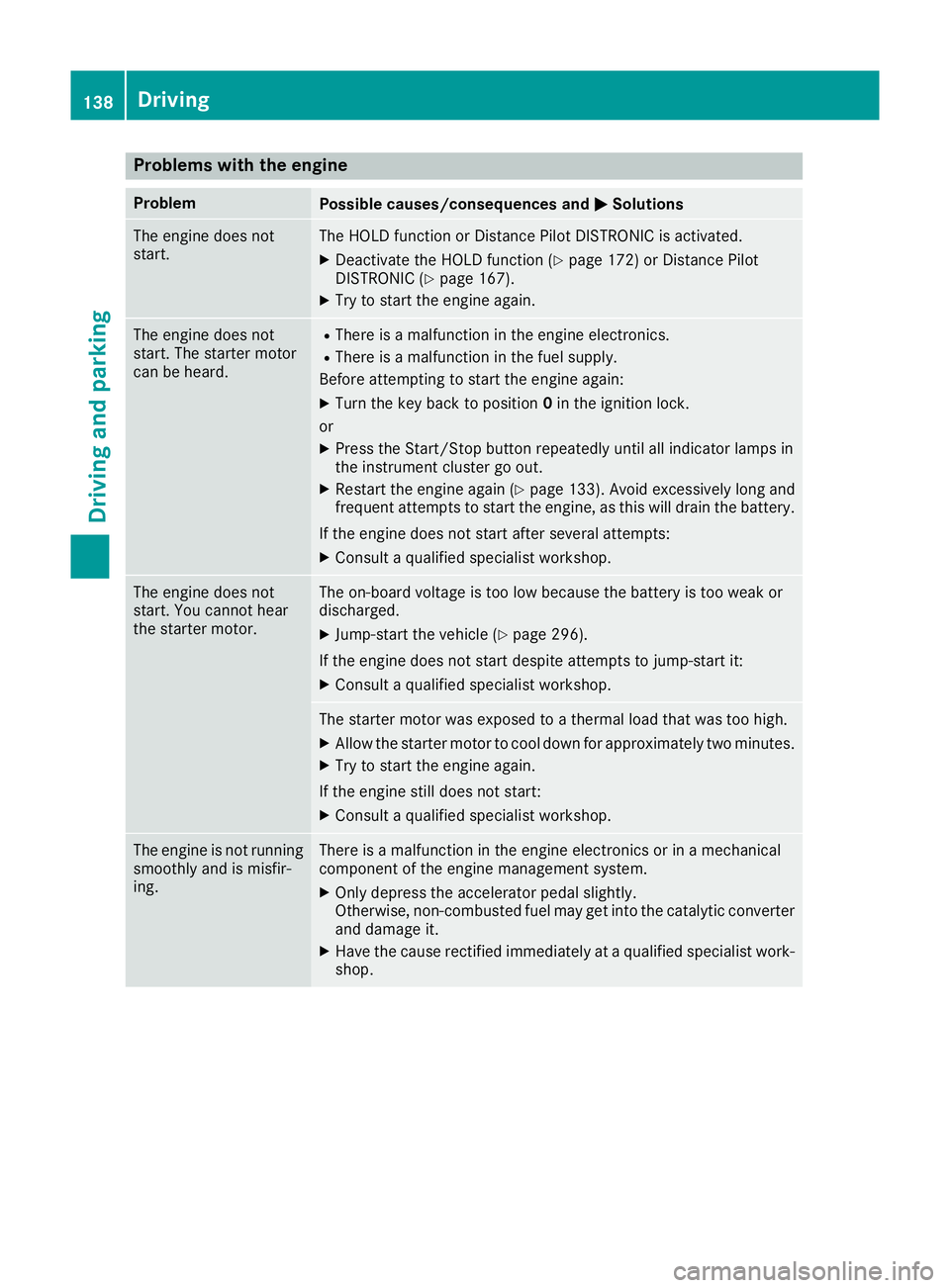
Problems with the engine
Problem
Possible causes/consequences and
M
MSolutions The engine does not
start. The HOLD function or Distance Pilot DISTRONIC is activated.
X Deactivate the HOLD function (Y page 172) or Distance Pilot
DISTRONIC (Y page 167).
X Try to start the engine again. The engine does not
start. The starter motor
can be heard. R
There is a malfunction in the engine electronics.
R There is a malfunction in the fuel supply.
Before attempting to start the engine again:
X Turn the key back to position 0in the ignition lock.
or X Press the Start/Stop button repeatedly until all indicator lamps in
the instrument cluster go out.
X Restart the engine again (Y page 133). Avoid excessively long and
frequent attempts to start the engine, as this will drain the battery.
If the engine does not start after several attempts:
X Consult a qualified specialist workshop. The engine does not
start. You cannot hear
the starter motor. The on-board voltage is too low because the battery is too weak or
discharged.
X Jump-start the vehicle (Y page 296).
If the engine does not start despite attempts to jump-start it:
X Consult a qualified specialist workshop. The starter motor was exposed to a thermal load that was too high.
X Allow the starter motor to cool down for approximately two minutes.
X Try to start the engine again.
If the engine still does not start: X Consult a qualified specialist workshop. The engine is not running
smoothly and is misfir-
ing. There is a malfunction in the engine electronics or in a mechanical
component of the engine management system.
X Only depress the accelerator pedal slightly.
Otherwise, non-combusted fuel may get into the catalytic converter
and damage it.
X Have the cause rectified immediately at a qualified specialist work-
shop. 138
DrivingDriving and parking
Page 142 of 333
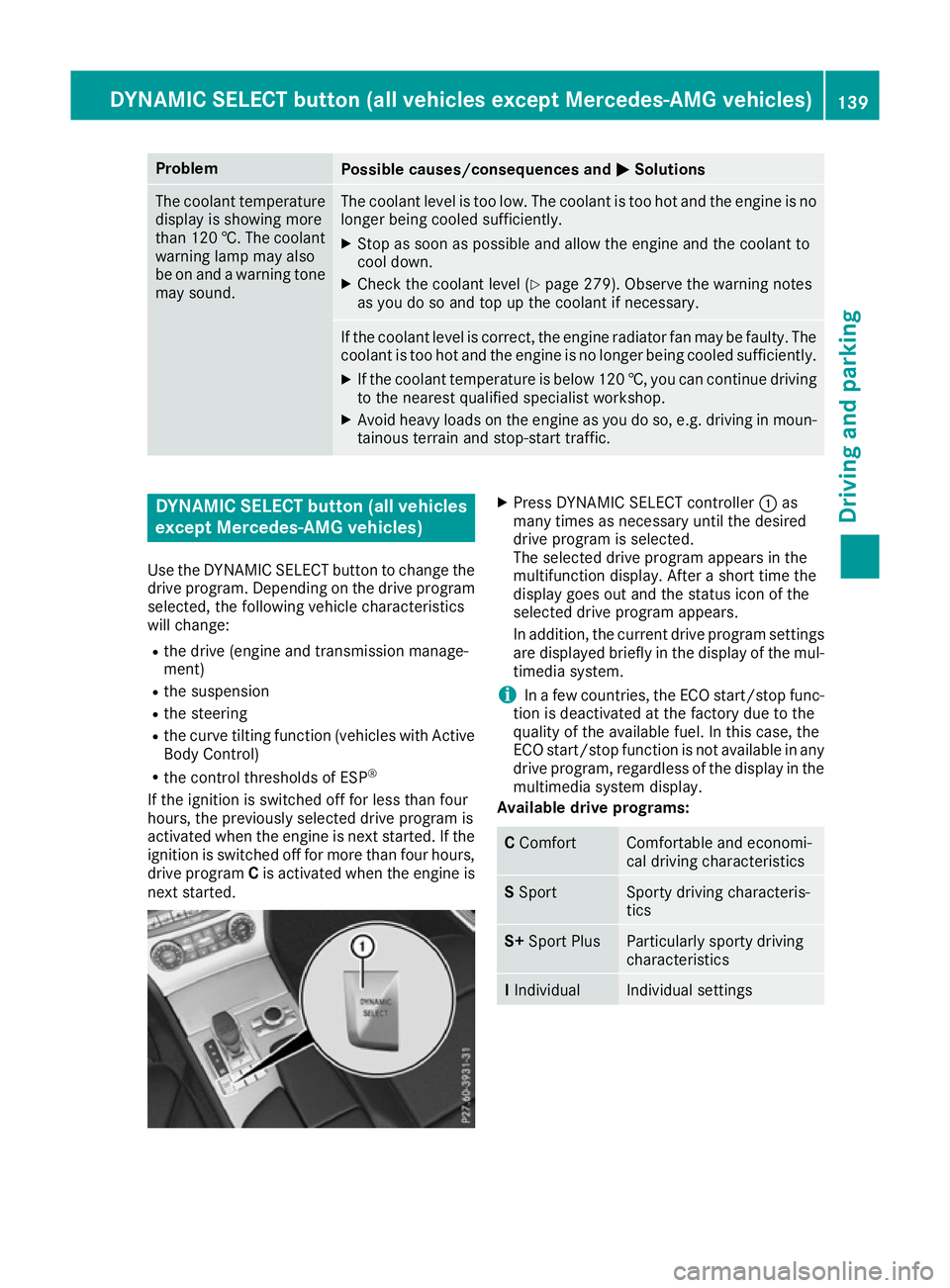
Problem
Possible causes/consequences and
M
MSolutions The coolant temperature
display is showing more
than 120 †. The coolant warning lamp may also
be on and a warning tone
may sound. The coolant level is too low. The coolant is too hot and the engine is no
longer being cooled sufficiently.
X Stop as soon as possible and allow the engine and the coolant to
cool down.
X Check the coolant level (Y page 279). Observe the warning notes
as you do so and top up the coolant if necessary. If the coolant level is correct, the engine radiator fan may be faulty. The
coolant is too hot and the engine is no longer being cooled sufficiently.
X If the coolant temperature is below 120 †, you can continue driving
to the nearest qualified specialist workshop.
X Avoid heavy loads on the engine as you do so, e.g. driving in moun-
tainous terrain and stop-start traffic. DYNAMIC SELECT button (all vehicles
except Mercedes-AMG vehicles)
Use the DYNAMIC SELECT button to change the drive program. Depending on the drive program
selected, the following vehicle characteristics
will change:
R the drive (engine and transmission manage-
ment)
R the suspension
R the steering
R the curve tilting function (vehicles with Active
Body Control)
R the control thresholds of ESP ®
If the ignition is switched off for less than four
hours, the previously selected drive program is
activated when the engine is next started. If the ignition is switched off for more than four hours,
drive program Cis activated when the engine is
next started. X
Press DYNAMIC SELECT controller :as
many times as necessary until the desired
drive program is selected.
The selected drive program appears in the
multifunction display. After a short time the
display goes out and the status icon of the
selected drive program appears.
In addition, the current drive program settings are displayed briefly in the display of the mul-
timedia system.
i In a few countries, the ECO start/stop func-
tion is deactivated at the factory due to the
quality of the available fuel. In this case, the
ECO start/stop function is not available in any
drive program, regardless of the display in the
multimedia system display.
Available drive programs: C
Comfort Comfortable and economi-
cal driving characteristics
S
Sport Sporty driving characteris-
tics
S+
Sport Plus Particularly sporty driving
characteristics
I
Individual Individual settingsDYNAMIC SELECT button (all vehicles except Mercedes-AMG vehicles)
139Driving and parking Z
Page 143 of 333
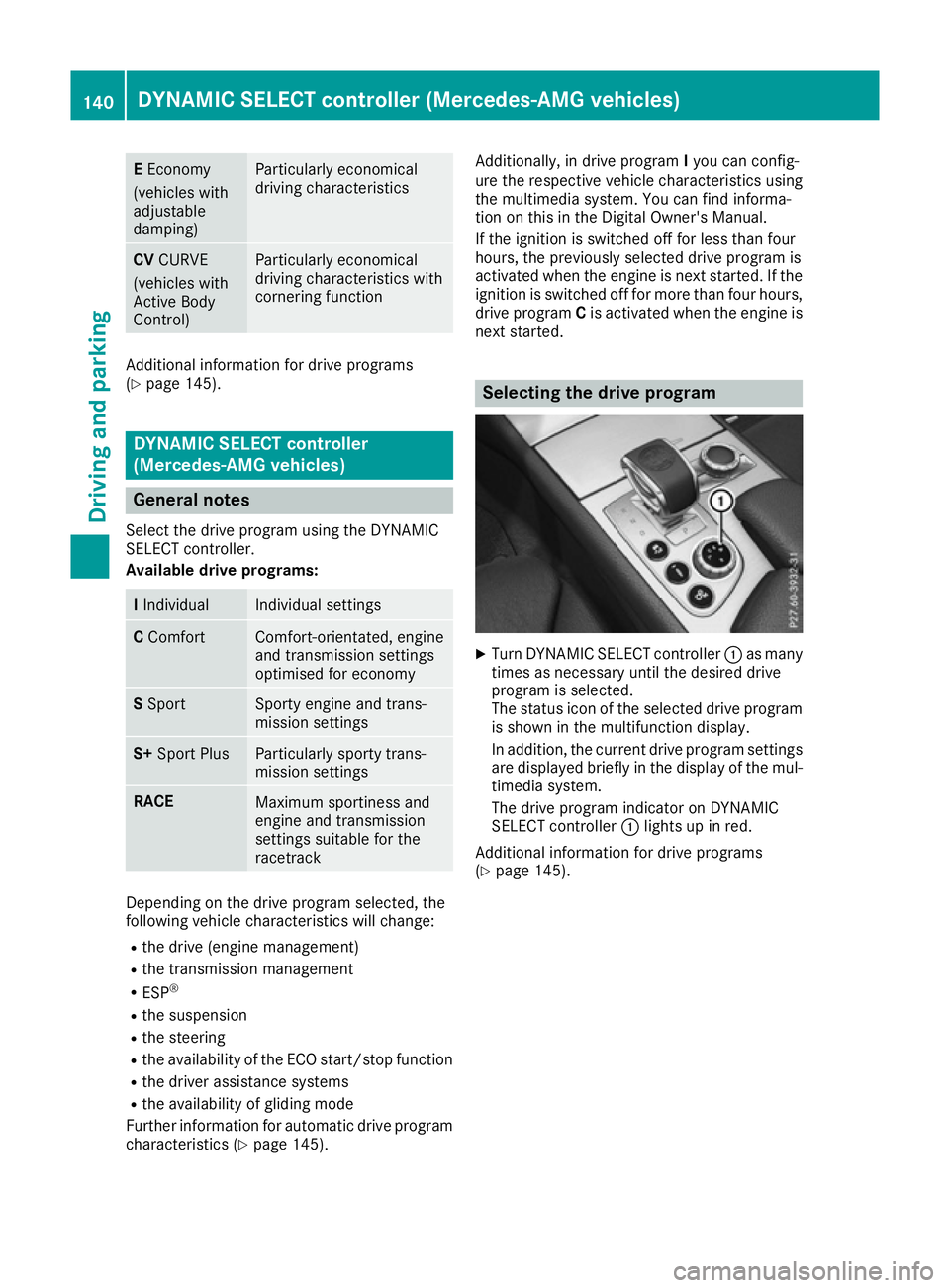
E
Economy
(vehicles with
adjustable
damping) Particularly economical
driving characteristics
CV
CURVE
(vehicles with
Active Body
Control) Particularly economical
driving characteristics with
cornering function
Additional information for drive programs
(Y
page 145). DYNAMIC SELECT controller
(Mercedes-AMG vehicles)
General notes
Select the drive program using the DYNAMIC
SELECT controller.
Available drive programs: I
Individual Individual settings
C
Comfort Comfort-orientated, engine
and transmission settings
optimised for economy
S
Sport Sporty engine and trans-
mission settings
S+
Sport Plus Particularly sporty trans-
mission settings
RACE
Maximum sportiness and
engine and transmission
settings suitable for the
racetrack Depending on the drive program selected, the
following vehicle characteristics will change:
R the drive (engine management)
R the transmission management
R ESP ®
R the suspension
R the steering
R the availability of the ECO start/stop function
R the driver assistance systems
R the availability of gliding mode
Further information for automatic drive program characteristics (Y page 145). Additionally, in drive program
Iyou can config-
ure the respective vehicle characteristics using
the multimedia system. You can find informa-
tion on this in the Digital Owner's Manual.
If the ignition is switched off for less than four
hours, the previously selected drive program is
activated when the engine is next started. If the ignition is switched off for more than four hours,
drive program Cis activated when the engine is
next started. Selecting the drive program
X
Turn DYNAMIC SELECT controller :as many
times as necessary until the desired drive
program is selected.
The status icon of the selected drive program
is shown in the multifunction display.
In addition, the current drive program settings are displayed briefly in the display of the mul-
timedia system.
The drive program indicator on DYNAMIC
SELECT controller :lights up in red.
Additional information for drive programs
(Y page 145). 140
DYNAMIC SELEC
Tcont roller (Mercedes-AMG vehi cles)Driving and parking
Page 144 of 333
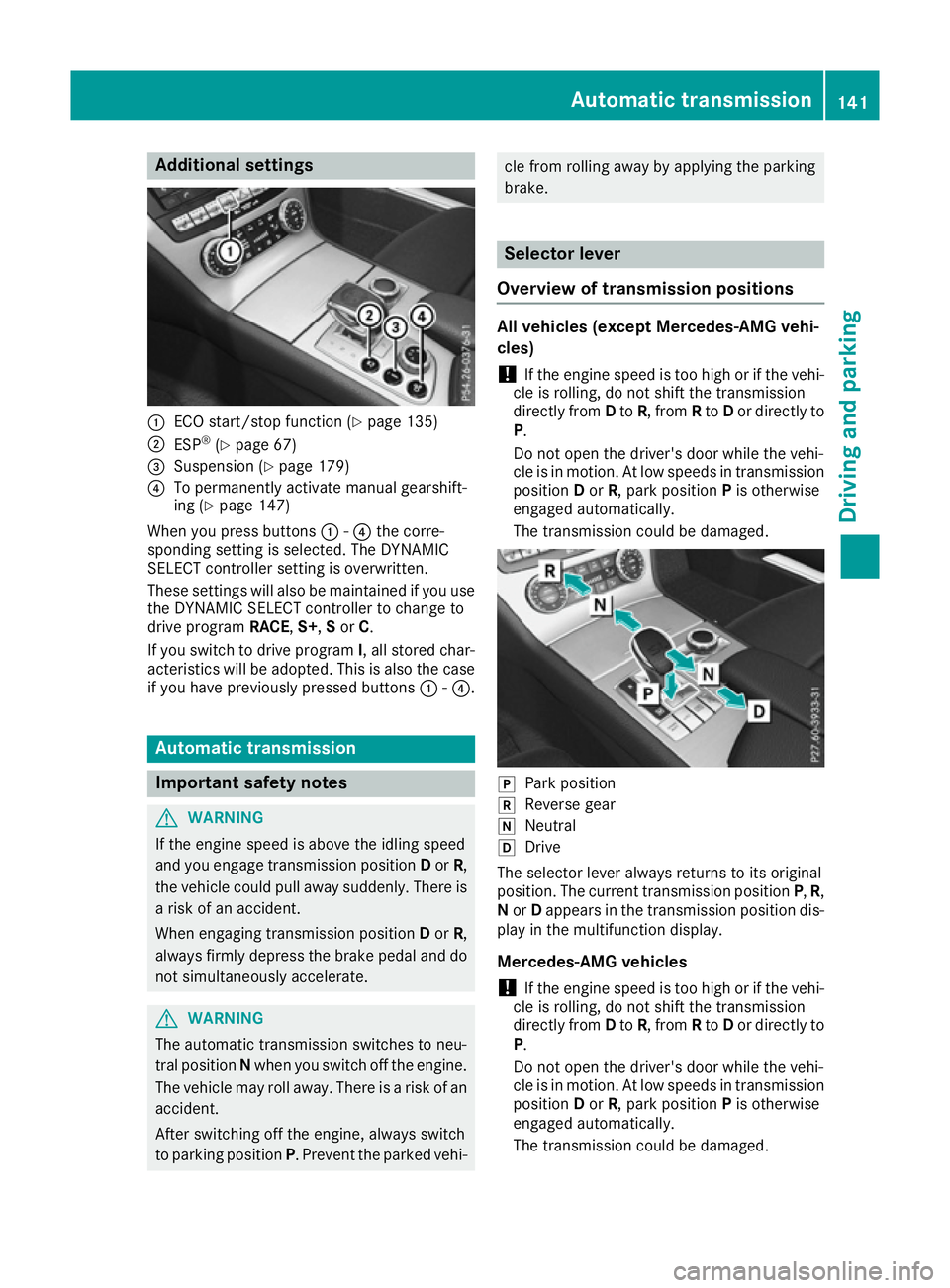
Additional settings
:
ECO start/stop function (Y page 135)
; ESP ®
(Y page 67)
= Suspension (Y page 179)
? To permanently activate manual gearshift-
ing (Y page 147)
When you press buttons :-? the corre-
sponding setting is selected. The DYNAMIC
SELECT controller setting is overwritten.
These settings will also be maintained if you use
the DYNAMIC SELECT controller to change to
drive program RACE,S+ ,S or C.
If you switch to drive program I, all stored char-
acteristics will be adopted. This is also the case
if you have previously pressed buttons :-?. Automatic transmission
Important safety notes
G
WARNING
If the engine speed is above the idling speed
and you engage transmission position Dor R,
the vehicle could pull away suddenly. There is a risk of an accident.
When engaging transmission position Dor R,
always firmly depress the brake pedal and do not simultaneously accelerate. G
WARNING
The automatic transmission switches to neu-
tral position Nwhen you switch off the engine.
The vehicle may roll away. There is a risk of an
accident.
After switching off the engine, always switch
to parking position P. Prevent the parked vehi- cle from rolling away by applying the parking
brake.
Selector lever
Overview of transmission positions All vehicles (except Mercedes-AMG vehi-
cles)
! If the engine speed is too high or if the vehi-
cle is rolling, do not shift the transmission
directly from Dto R, from Rto Dor directly to
P.
Do not open the driver's door while the vehi-
cle is in motion. At low speeds in transmission position Dor R, park position Pis otherwise
engaged automatically.
The transmission could be damaged. j
Park position
k Reverse gear
i Neutral
h Drive
The selector lever always returns to its original
position. The current transmission position P,R,
N or Dappears in the transmission position dis-
play in the multifunction display.
Mercedes-AMG vehicles
! If the engine speed is too high or if the vehi-
cle is rolling, do not shift the transmission
directly from Dto R, from Rto Dor directly to
P.
Do not open the driver's door while the vehi-
cle is in motion. At low speeds in transmission position Dor R, park position Pis otherwise
engaged automatically.
The transmission could be damaged. Automatic trans
mission
141Driving an d parking Z
Page 145 of 333
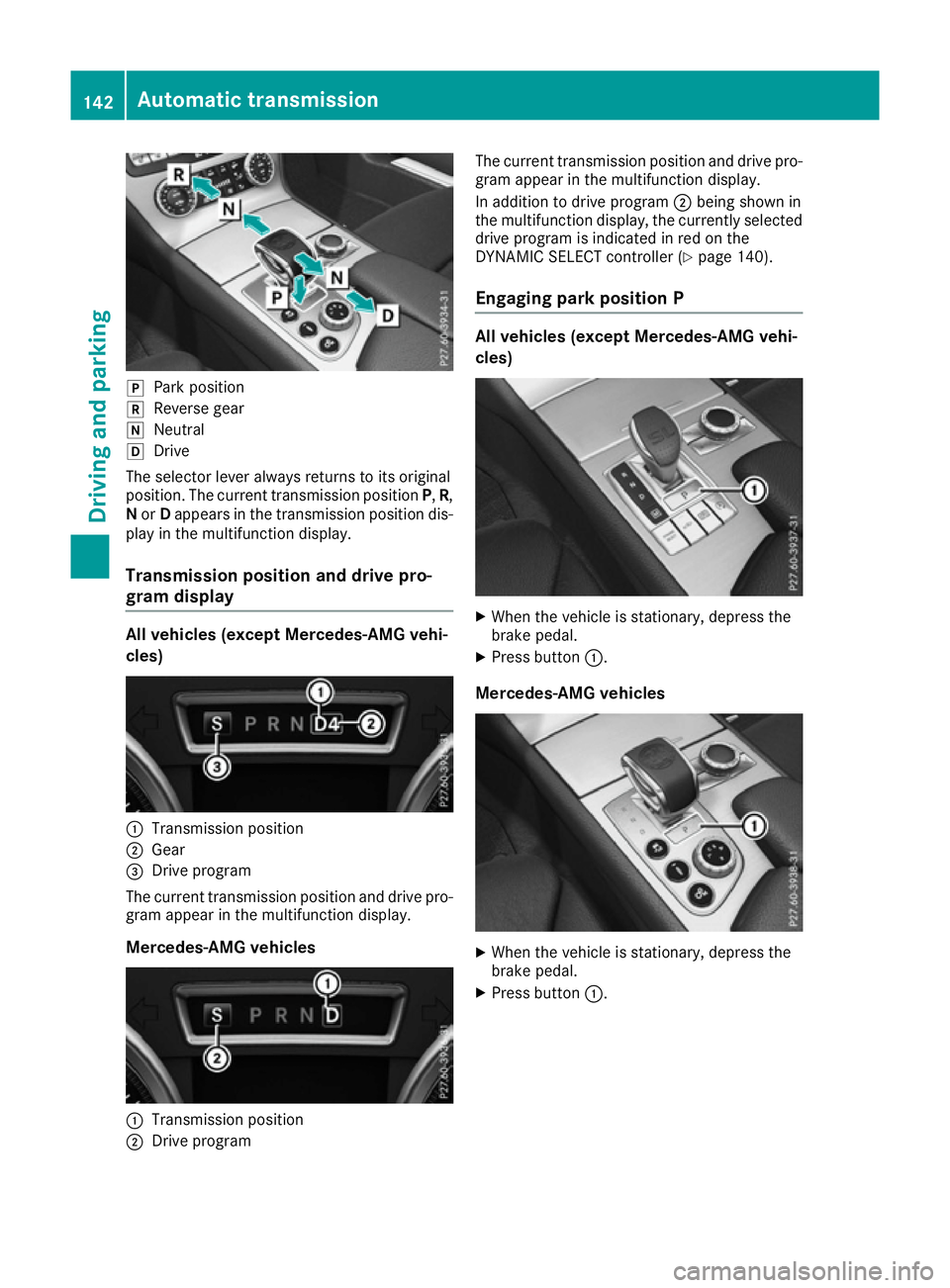
j
Park position
k Reverse gear
i Neutral
h Drive
The selector lever always returns to its original
position. The current transmission position P,R,
N or Dappears in the transmission position dis-
play in the multifunction display.
Transmission position and drive pro-
gram display All vehicles (except Mercedes-AMG vehi-
cles)
:
Transmission position
; Gear
= Drive program
The current transmission position and drive pro-
gram appear in the multifunction display.
Mercedes-AMG vehicles :
Transmission position
; Drive program The current transmission position and drive pro-
gram appear in the multifunction display.
In addition to drive program ;being shown in
the multifunction display, the currently selected
drive program is indicated in red on the
DYNAMIC SELECT controller (Y page 140).
Engaging park position P All vehicles (except Mercedes-AMG vehi-
cles)
X
When the vehicle is stationary, depress the
brake pedal.
X Press button :.
Mercedes-AMG vehicles X
When the vehicle is stationary, depress the
brake pedal.
X Press button :.142
Automatic transmissionDriving and parking
Page 146 of 333
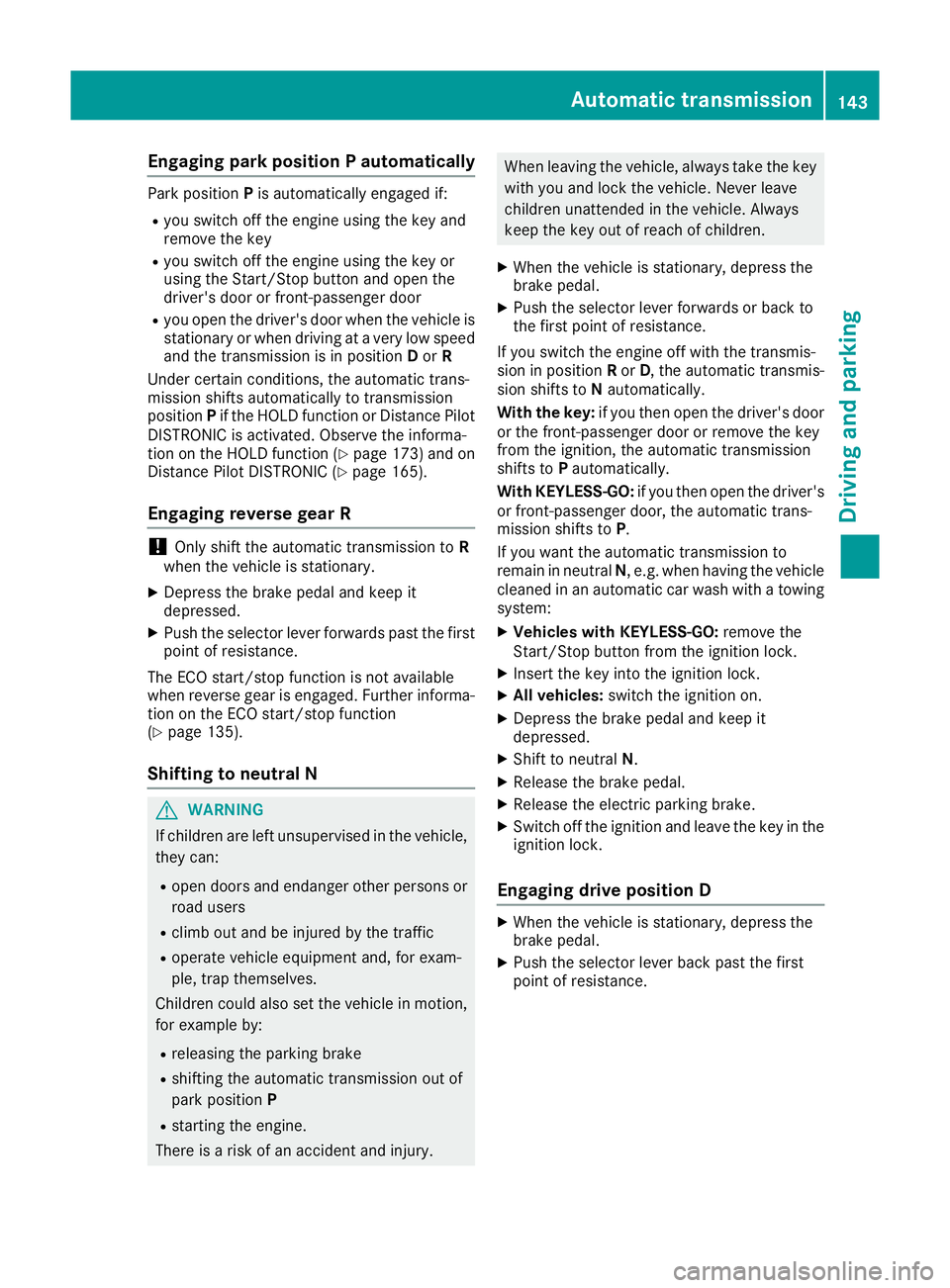
Engaging park position P automatically
Park position
Pis automatically engaged if:
R you switch off the engine using the key and
remove the key
R you switch off the engine using the key or
using the Start/Stop button and open the
driver's door or front-passenger door
R you open the driver's door when the vehicle is
stationary or when driving at a very low speed
and the transmission is in position Dor R
Under certain conditions, the automatic trans-
mission shifts automatically to transmission
position Pif the HOLD function or Distance Pilot
DISTRONIC is activated. Observe the informa-
tion on the HOLD function (Y page 173) and on
Distance Pilot DISTRONIC (Y page 165).
Engaging reverse gear R !
Only shift the automatic transmission to
R
when the vehicle is stationary.
X Depress the brake pedal and keep it
depressed.
X Push the selector lever forwards past the first
point of resistance.
The ECO start/stop function is not available
when reverse gear is engaged. Further informa-
tion on the ECO start/stop function
(Y page 135).
Shifting to neutral N G
WARNING
If children are left unsupervised in the vehicle, they can:
R open doors and endanger other persons or
road users
R climb out and be injured by the traffic
R operate vehicle equipment and, for exam-
ple, trap themselves.
Children could also set the vehicle in motion, for example by:
R releasing the parking brake
R shifting the automatic transmission out of
park position P
R starting the engine.
There is a risk of an accident and injury. When leaving the vehicle, always take the key
with you and lock the vehicle. Never leave
children unattended in the vehicle. Always
keep the key out of reach of children.
X When the vehicle is stationary, depress the
brake pedal.
X Push the selector lever forwards or back to
the first point of resistance.
If you switch the engine off with the transmis-
sion in position Ror D, the automatic transmis-
sion shifts to Nautomatically.
With the key: if you then open the driver's door
or the front-passenger door or remove the key
from the ignition, the automatic transmission
shifts to Pautomatically.
With KEYLESS-GO: if you then open the driver's
or front-passenger door, the automatic trans-
mission shifts to P.
If you want the automatic transmission to
remain in neutral N, e.g. when having the vehicle
cleaned in an automatic car wash with a towing
system:
X Vehicles with KEYLESS-GO: remove the
Start/Stop button from the ignition lock.
X Insert the key into the ignition lock.
X All vehicles: switch the ignition on.
X Depress the brake pedal and keep it
depressed.
X Shift to neutral N.
X Release the brake pedal.
X Release the electric parking brake.
X Switch off the ignition and leave the key in the
ignition lock.
Engaging drive position D X
When the vehicle is stationary, depress the
brake pedal.
X Push the selector lever back past the first
point of resistance. Automatic transmission
143Driving and parking Z
Page 147 of 333
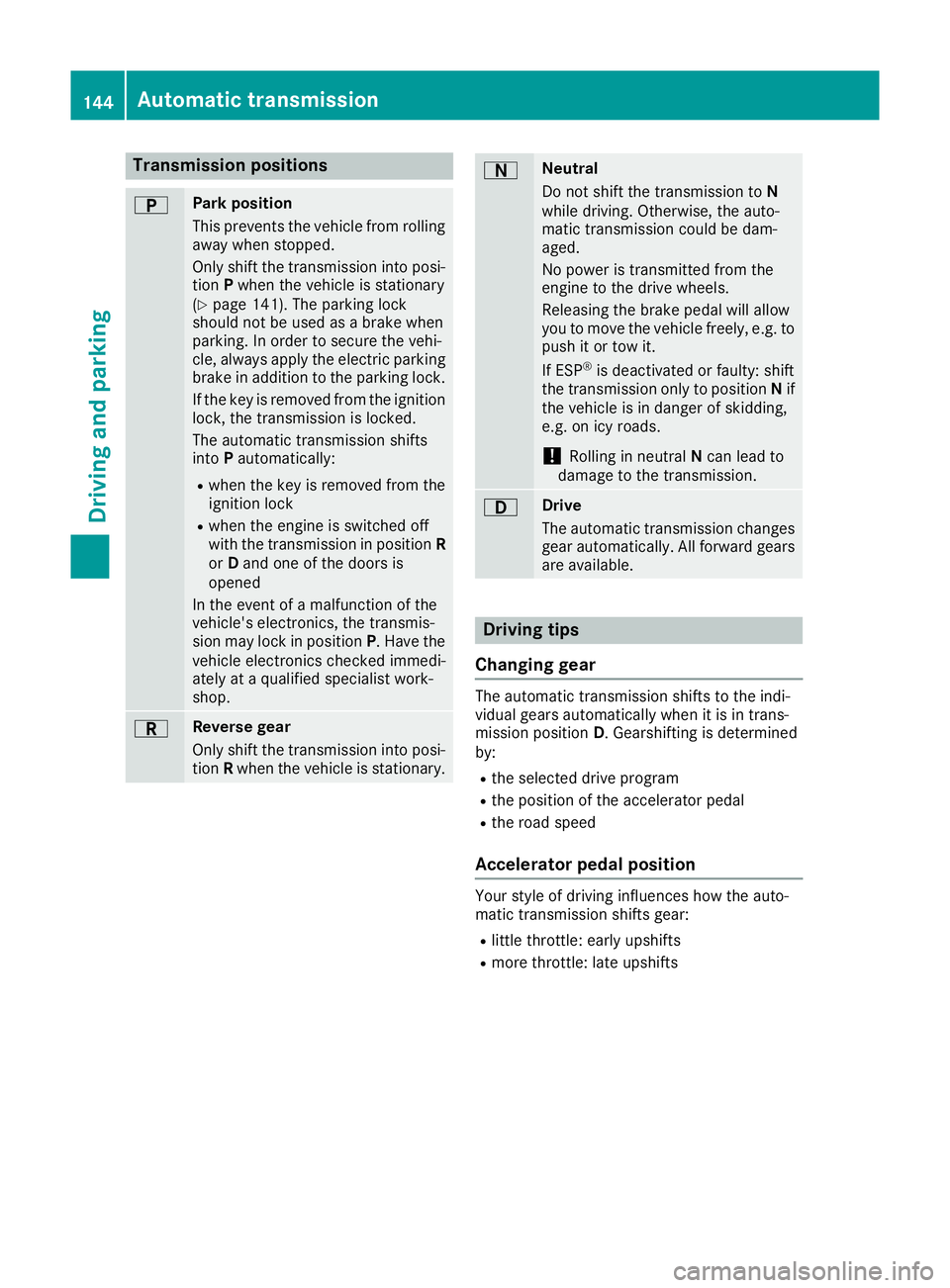
Transmission positions
B Park position
This prevents the vehicle from rolling away when stopped.
Only shift the transmission into posi-
tion Pwhen the vehicle is stationary
(Y page 141). The parking lock
should not be used as a brake when
parking. In order to secure the vehi-
cle, always apply the electric parking
brake in addition to the parking lock.
If the key is removed from the ignition lock, the transmission is locked.
The automatic transmission shifts
into Pautomatically:
R when the key is removed from the
ignition lock
R when the engine is switched off
with the transmission in position R
or Dand one of the doors is
opened
In the event of a malfunction of the
vehicle's electronics, the transmis-
sion may lock in position P. Have the
vehicle electronics checked immedi-
ately at a qualified specialist work-
shop. C Reverse gear
Only shift the transmission into posi- tion Rwhen the vehicle is stationary. A Neutral
Do not shift the transmission to
N
while driving. Otherwise, the auto-
matic transmission could be dam-
aged.
No power is transmitted from the
engine to the drive wheels.
Releasing the brake pedal will allow
you to move the vehicle freely, e.g. to push it or tow it.
If ESP ®
is deactivated or faulty: shift
the transmission only to position Nif
the vehicle is in danger of skidding,
e.g. on icy roads.
! Rolling in neutral
Ncan lead to
damage to the transmission. 7 Drive
The automatic transmission changes
gear automatically. All forward gears
are available. Driving tips
Changing gear The automatic transmission shifts to the indi-
vidual gears automatically when it is in trans-
mission position
D. Gearshifting is determined
by:
R the selected drive program
R the position of the accelerator pedal
R the road speed
Accelerator pedal position Your style of driving influences how the auto-
matic transmission shifts gear:
R little throttle: early upshifts
R more throttle: late upshifts 144
Automatic transmissionDriving an
d parking
Page 148 of 333
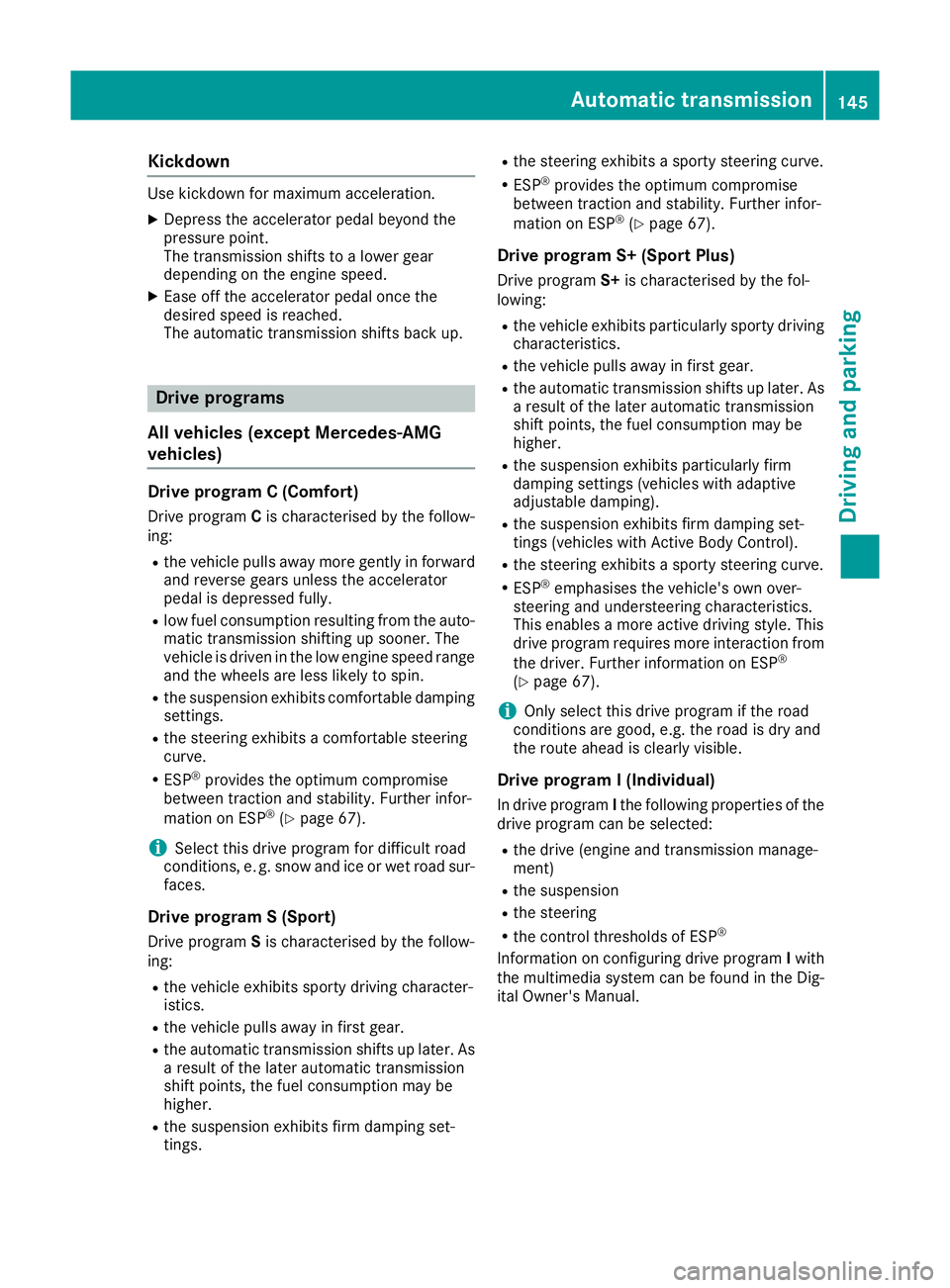
Kickdown
Use kickdown for maximum acceleration.
X Depress the accelerator pedal beyond the
pressure point.
The transmission shifts to a lower gear
depending on the engine speed.
X Ease off the accelerator pedal once the
desired speed is reached.
The automatic transmission shifts back up. Drive programs
All vehicles (except Mercedes-AMG
vehicles) Drive program C (Comfort)
Drive program Cis characterised by the follow-
ing:
R the vehicle pulls away more gently in forward
and reverse gears unless the accelerator
pedal is depressed fully.
R low fuel consumption resulting from the auto-
matic transmission shifting up sooner. The
vehicle is driven in the low engine speed range
and the wheels are less likely to spin.
R the suspension exhibits comfortable damping
settings.
R the steering exhibits a comfortable steering
curve.
R ESP ®
provides the optimum compromise
between traction and stability. Further infor-
mation on ESP ®
(Y page 67).
i Select this drive program for difficult road
conditions, e. g. snow and ice or wet road sur- faces.
Drive program S (Sport) Drive program Sis characterised by the follow-
ing:
R the vehicle exhibits sporty driving character-
istics.
R the vehicle pulls away in first gear.
R the automatic transmission shifts up later. As
a result of the later automatic transmission
shift points, the fuel consumption may be
higher.
R the suspension exhibits firm damping set-
tings. R
the steering exhibits a sporty steering curve.
R ESP ®
provides the optimum compromise
between traction and stability. Further infor-
mation on ESP ®
(Y page 67).
Drive program S+ (Sport Plus)
Drive program S+is characterised by the fol-
lowing:
R the vehicle exhibits particularly sporty driving
characteristics.
R the vehicle pulls away in first gear.
R the automatic transmission shifts up later. As
a result of the later automatic transmission
shift points, the fuel consumption may be
higher.
R the suspension exhibits particularly firm
damping settings (vehicles with adaptive
adjustable damping).
R the suspension exhibits firm damping set-
tings (vehicles with Active Body Control).
R the steering exhibits a sporty steering curve.
R ESP ®
emphasises the vehicle's own over-
steering and understeering characteristics.
This enables a more active driving style. This
drive program requires more interaction from
the driver. Further information on ESP ®
(Y page 67).
i Only select this drive program if the road
conditions are good, e.g. the road is dry and
the route ahead is clearly visible.
Drive program I (Individual)
In drive program Ithe following properties of the
drive program can be selected:
R the drive (engine and transmission manage-
ment)
R the suspension
R the steering
R the control thresholds of ESP ®
Information on configuring drive program Iwith
the multimedia system can be found in the Dig-
ital Owner's Manual. Automatic trans
mission
145Driving an d parking Z
Page 149 of 333
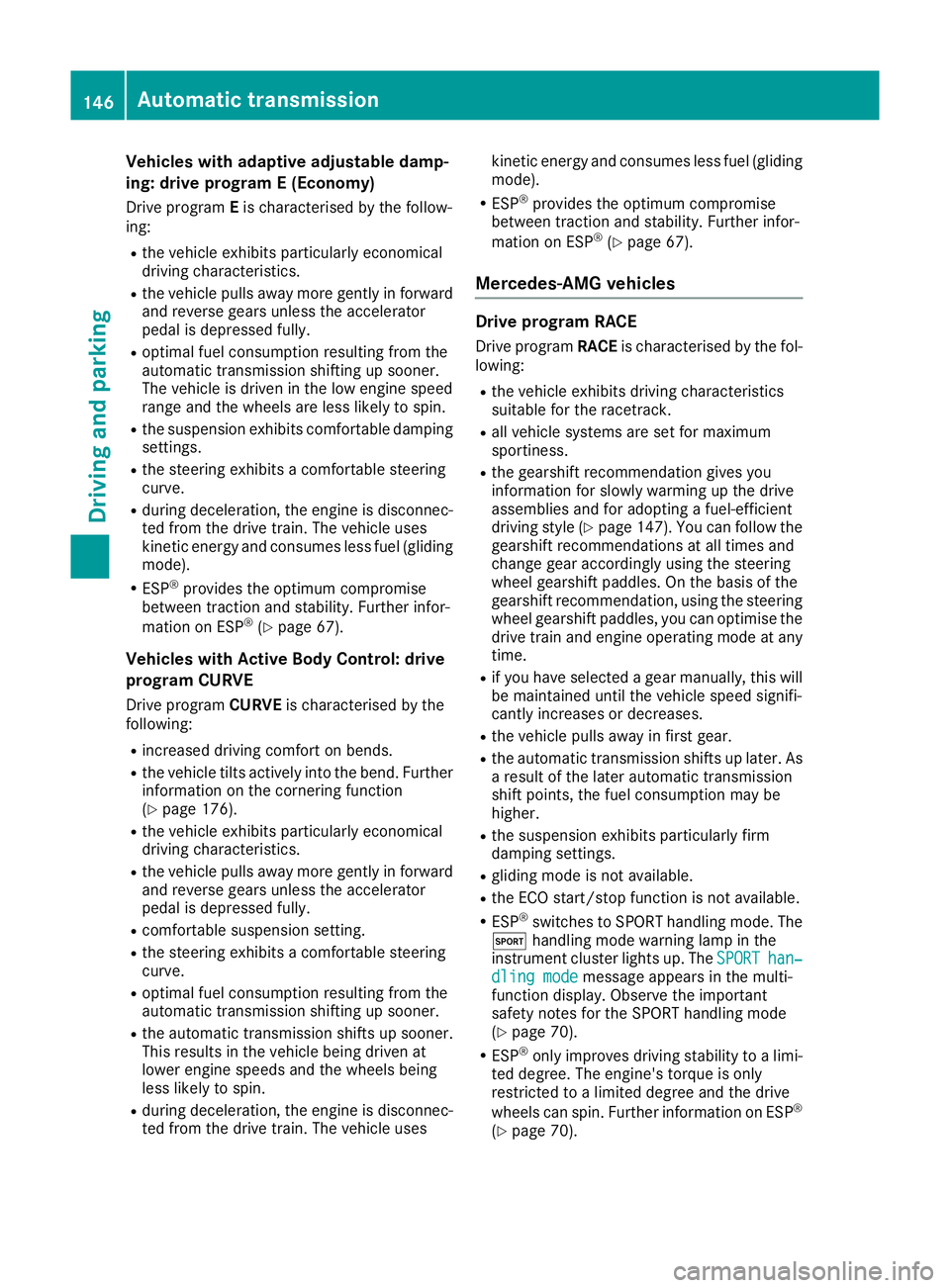
Vehicles with adaptive adjustable damp-
ing: drive program E (Economy)
Drive program Eis characterised by the follow-
ing:
R the vehicle exhibits particularly economical
driving characteristics.
R the vehicle pulls away more gently in forward
and reverse gears unless the accelerator
pedal is depressed fully.
R optimal fuel consumption resulting from the
automatic transmission shifting up sooner.
The vehicle is driven in the low engine speed
range and the wheels are less likely to spin.
R the suspension exhibits comfortable damping
settings.
R the steering exhibits a comfortable steering
curve.
R during deceleration, the engine is disconnec-
ted from the drive train. The vehicle uses
kinetic energy and consumes less fuel (gliding
mode).
R ESP ®
provides the optimum compromise
between traction and stability. Further infor-
mation on ESP ®
(Y page 67).
Vehicles with Active Body Control: drive
program CURVE
Drive program CURVEis characterised by the
following:
R increased driving comfort on bends.
R the vehicle tilts actively into the bend. Further
information on the cornering function
(Y page 176).
R the vehicle exhibits particularly economical
driving characteristics.
R the vehicle pulls away more gently in forward
and reverse gears unless the accelerator
pedal is depressed fully.
R comfortable suspension setting.
R the steering exhibits a comfortable steering
curve.
R optimal fuel consumption resulting from the
automatic transmission shifting up sooner.
R the automatic transmission shifts up sooner.
This results in the vehicle being driven at
lower engine speeds and the wheels being
less likely to spin.
R during deceleration, the engine is disconnec-
ted from the drive train. The vehicle uses kinetic energy and consumes less fuel (gliding
mode).
R ESP ®
provides the optimum compromise
between traction and stability. Further infor-
mation on ESP ®
(Y page 67).
Mercedes-AMG vehicles Drive program RACE
Drive program RACEis characterised by the fol-
lowing:
R the vehicle exhibits driving characteristics
suitable for the racetrack.
R all vehicle systems are set for maximum
sportiness.
R the gearshift recommendation gives you
information for slowly warming up the drive
assemblies and for adopting a fuel-efficient
driving style (Y page 147). You can follow the
gearshift recommendations at all times and
change gear accordingly using the steering
wheel gearshift paddles. On the basis of the
gearshift recommendation, using the steering
wheel gearshift paddles, you can optimise the drive train and engine operating mode at any
time.
R if you have selected a gear manually, this will
be maintained until the vehicle speed signifi-
cantly increases or decreases.
R the vehicle pulls away in first gear.
R the automatic transmission shifts up later. As
a result of the later automatic transmission
shift points, the fuel consumption may be
higher.
R the suspension exhibits particularly firm
damping settings.
R gliding mode is not available.
R the ECO start/stop function is not available.
R ESP ®
switches to SPORT handling mode. The
M handling mode warning lamp in the
instrument cluster lights up. The SPORT SPORThan‐
han‐
dling mode
dling mode message appears in the multi-
function display. Observe the important
safety notes for the SPORT handling mode
(Y page 70).
R ESP ®
only improves driving stability to a limi-
ted degree. The engine's torque is only
restricted to a limited degree and the drive
wheels can spin. Further information on ESP ®
(Y page 70). 146
Automatic transmissionDriving and parking
Page 150 of 333
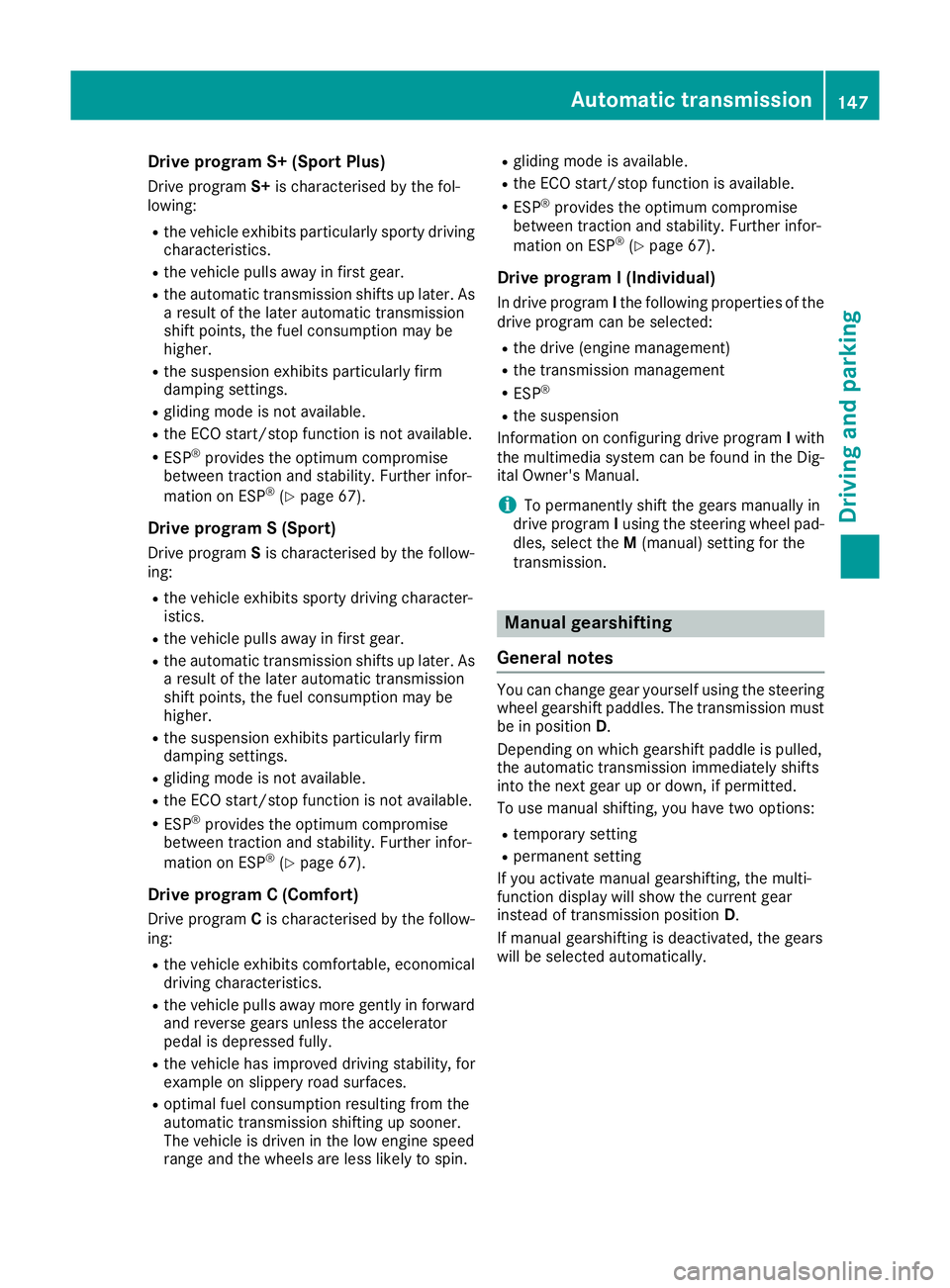
Drive program S+ (Sport Plus)
Drive program S+is characterised by the fol-
lowing:
R the vehicle exhibits particularly sporty driving
characteristics.
R the vehicle pulls away in first gear.
R the automatic transmission shifts up later. As
a result of the later automatic transmission
shift points, the fuel consumption may be
higher.
R the suspension exhibits particularly firm
damping settings.
R gliding mode is not available.
R the ECO start/stop function is not available.
R ESP ®
provides the optimum compromise
between traction and stability. Further infor-
mation on ESP ®
(Y page 67).
Drive program S (Sport) Drive program Sis characterised by the follow-
ing:
R the vehicle exhibits sporty driving character-
istics.
R the vehicle pulls away in first gear.
R the automatic transmission shifts up later. As
a result of the later automatic transmission
shift points, the fuel consumption may be
higher.
R the suspension exhibits particularly firm
damping settings.
R gliding mode is not available.
R the ECO start/stop function is not available.
R ESP ®
provides the optimum compromise
between traction and stability. Further infor-
mation on ESP ®
(Y page 67).
Drive program C (Comfort) Drive program Cis characterised by the follow-
ing:
R the vehicle exhibits comfortable, economical
driving characteristics.
R the vehicle pulls away more gently in forward
and reverse gears unless the accelerator
pedal is depressed fully.
R the vehicle has improved driving stability, for
example on slippery road surfaces.
R optimal fuel consumption resulting from the
automatic transmission shifting up sooner.
The vehicle is driven in the low engine speed
range and the wheels are less likely to spin. R
gliding mode is available.
R the ECO start/stop function is available.
R ESP ®
provides the optimum compromise
between traction and stability. Further infor-
mation on ESP ®
(Y page 67).
Drive program I (Individual)
In drive program Ithe following properties of the
drive program can be selected:
R the drive (engine management)
R the transmission management
R ESP ®
R the suspension
Information on configuring drive program Iwith
the multimedia system can be found in the Dig-
ital Owner's Manual.
i To permanently shift the gears manually in
drive program Iusing the steering wheel pad-
dles, select the M(manual) setting for the
transmission. Manual gearshifting
General notes You can change gear yourself using the steering
wheel gearshift paddles. The transmission must
be in position D.
Depending on which gearshift paddle is pulled,
the automatic transmission immediately shifts
into the next gear up or down, if permitted.
To use manual shifting, you have two options:
R temporary setting
R permanent setting
If you activate manual gearshifting, the multi-
function display will show the current gear
instead of transmission position D.
If manual gearshifting is deactivated, the gears
will be selected automatically. Automatic transmission
147Driving and parking Z